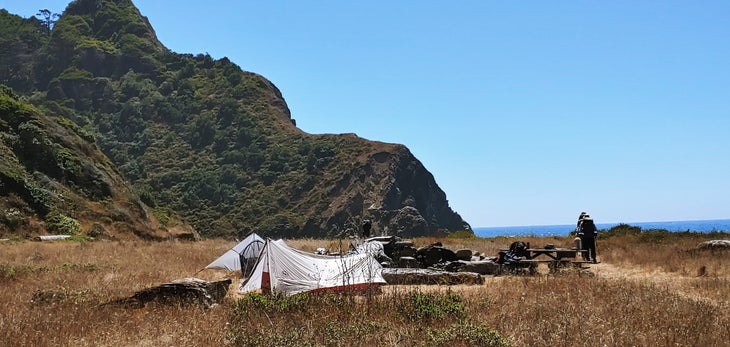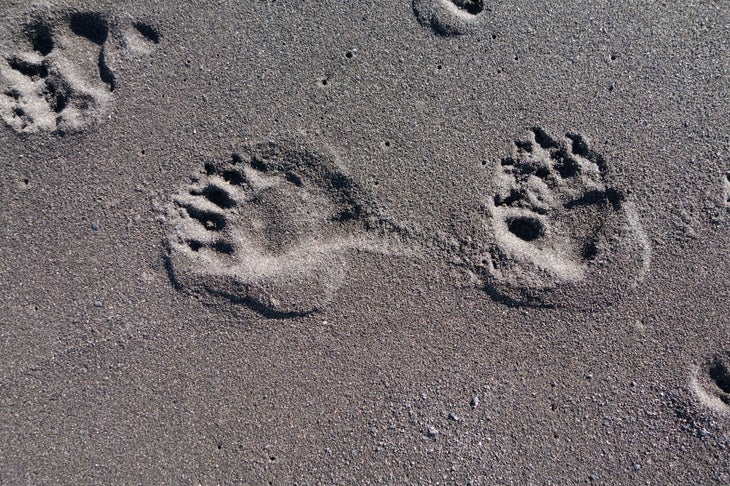“], “filter”: { “nextExceptions”: “img, blockquote, div”, “nextContainsExceptions”: “img, blockquote, a.btn, a.o-button”} }”>
Heading out the door? Read this article on the new Outside+ app available now on iOS devices for members!
>”,”name”:”in-content-cta”,”type”:”link”}}”>Download the app.
The cliff’s-edge coastline, rocky beaches and scrubby chaparral of California’s Lost Coast Trail are enough to make hikers feel like they’re a million miles from civilization, even though the trail is a mere half-day’s drive from the Bay Area. In the country’s most populous state, it’s one of the few places where avid backpackers can still go to escape city stressors and explore the rugged wilds of the King Range Wilderness.
Curious seals, intelligent otters, and elusive black bears all live along this stretch of Northern California’s coast, and as such, it’s important to come prepared and well-researched. In addition, backpackers looking to hike along the Lost Coast must consult a tide chart throughout their journey. There are three large stretches of trail that are impassable, except at low tide.
Below, we’ll get into the details of tackling this stunning scenic trail and answer some of your burning questions about trekking it safely.
How many miles is the Lost Coast Trail?
The main route that most hikers are talking about when they mention the “Lost Coast Trail” is a 25.65-mile stretch of ragged Pacific coastline that stretches from Mattole Beach in the north to Black Sands Beach in the south. Technically, this is the northern section of the Lost Coast Trail (there’s an option to extend another 19 miles into Sinkyone Wilderness State Park), but it’s the chunk that’s most worth doing. Mattole Beach is a five-and-a-half hour drive from San Francisco and an 11.5-hour drive from Los Angeles.
How long does it take to hike the Lost Coast Trail?
Most people complete the Lost Coast Trail in three or four days. Because of the sandy shoreline, rugged terrain and necessary tide charts, it’s important to allow for extra time each day to traverse this path safely.
Do you need a permit to hike the Lost Coast Trail?
Yes, you need a permit to hike the Lost Coast Trail. Head to Recreation.gov and search for King Range Wilderness Permits, then select your desired date range. You can make permits for groups of three or less. They cost $12 per person, plus a $6 reservation fee for the entire group. Between September 16 and May 14, 30 people per day may reserve a permit. Between May 15 and September 15, 60 people per day may reserve a permit. These permits are available in a three-month rolling window.
What’s a standard itinerary for the Lost Coast Trail?
Most people complete the Lost Coast Trail in three days. Because this trek is a point-to-point thru-hike, we recommend shuttling cars between the trailheads or hiring a shuttle service from Lost Coast Adventure Tours to take you to from Black Sands Beach up to Mattole, so when you finish trekking, you’re at your vehicle.
Day 1 – Mattole Beach to Randall Creek
Distance: 8.5 miles
It’s mission-critical to consult a tide chart every day that you’re hiking the Lost Coast Trail because it’s going to potentially change your desired itinerary. A good trajectory for day one is heading south to either Sea Lion Gulch Camp (4.5 miles into the trek) or Randall Creek (8.5 miles into the trek and just past the first impassable tidal zone). If you desire to overnight after your shuttle and time the tides properly for a big first day, there’s a first-come, first-served campground at Mattole Beach.
Hiking southbound will generally put the wind at your back, which makes for a much more enjoyable trip. (Trust us, we’ve learned the hard way.) The trail will undulate along grassy hills and dark sand beaches. Keep your eyes peeled for soaring seabirds as the whooshing of waves creates a mellow soundtrack to your hike. After roughly 4.25 miles, you’ll reach Sea Lion Rock, named for the adorable pinnipeds that frequent the area.
Here you have a decision to make: Either camp with an incredible ocean view at Sea Lion Gulch or consult your tide chart and see if the tide is going down enough to navigate the next 4- to 5-mile stretch of beach. The King Range National Recreation Area has created this invaluable guide to understanding the trail’s impassable zones, and they recommend crossing over to Randall Creek only if the tide is under 2.5 feet.

Day 2 – Randall Creek to Miller Flat
Distance: 8.5 miles
From Randall Creek Camp, you’ll get to enjoy a nice, “normal,” hard-packed trail on a grassy bluff known as Spanish Flat. Enjoy the sea breeze and the lack of strain on your calves. As you saunter along, you’ll pass some dry campsites and vintage cabins—relics from before the area became a conservation zone—then descend to the beach before reaching Big Flat.
Next up is some beautiful, cliffside hiking along Miller Flat. If you’ve got enough water and it’s too late to hit the next impassable zone at low tide, this is a decent spot to set up your tent for the night. Pro tip: you should fill up your Nalgenes at Big Flat, a half-mile before camp. The next section is a tidal zone of roughly 4 to 5 miles that you can only safely cross if the tide is below 3 feet.

Day 3 – Miller Flat to Black Sands Beach
Distance: 8.5 miles
Time your departure from camp to coincide with low tide, then get ready for some sandy hiking and sincerely stunning scenery. You’ll pass Shipman Creek, Buck Creek, and Gitchell Creek, the last of which marks the end of the impassable tidal area. Enjoy the craggy coastline and feel free to restock on water when you cross the freshwater creeks.
After Gitchell Creek, you’ve made it through all the impassable zones. Congratulations. From here, it’s only 4 miles to the trek’s end. Wind past forested cliffs as cresting waves serenade you from the west. You’ll pass a series of immense boulders before turning left and moving inland at Telegraph Creek. A series of signs marks the parking lot at Black Sands Beach.
How difficult is the Lost Coast Trail?
The Lost Coast Trail is a moderate trek for trained, prepared backpackers. Because it undulates along the coastline, mostly skirting the beach, there’s negligible elevation gain. The main safety (and ankle-snapping) concerns are boulder hopping in the trek’s tidal zones, the trail’s many creek crossings, and unpredictable “sneaker waves.”
Can you have campfires on the Lost Coast Trail?
Yes, but you’ll need to take a short online course and procure a California campfire permit. This online questionnaire and series of videos is totally free, and it’s a great way to brush up on your fire-suppressing skills before heading out.

Are there bears on the Lost Coast Trail?
Yes, there are black bears in sections of the Lost Coast Trail. As such, the governing body of the King Range Wilderness requires that all hikers carry a hard-sided, bear-resistant food storage container to store their smellables in the evening.
What to pack for the Lost Coast Trail?
In addition to following our handy packing list for backpackers, there are a few key things you’ll want to stash before heading out on the Lost Coast Trail.
-A hard-sided bear canister
As we mentioned before, there are black bears in this region of California, and hikers must bring a bear can on this trek. We think the BearVault BV500 will suit the needs of most backpackers.
-A good rain jacket
Because of errant coastal storms and the strong winds that some hikers may experience, we’d recommend having solid raingear on this hike. Need a recommendation? Check out our reviews for the best men’s and women’s shells and rainjackets for 2025.
-Sturdy trekking poles
Given the number of miles you’ll be hiking on sand, rocks, and damp tidal zones, having great trekking poles is key. The Leki SkyTera is a lightweight choice that packs down neatly into your pack when not in use.
-Hiking gaiters
To avoid getting abrasive sand in your nice hiking boots, it’s recommended to pack a pair of hiking gaiters. We like the colorful, downright psychedelic styles at Dirty Girl Gaiters.
